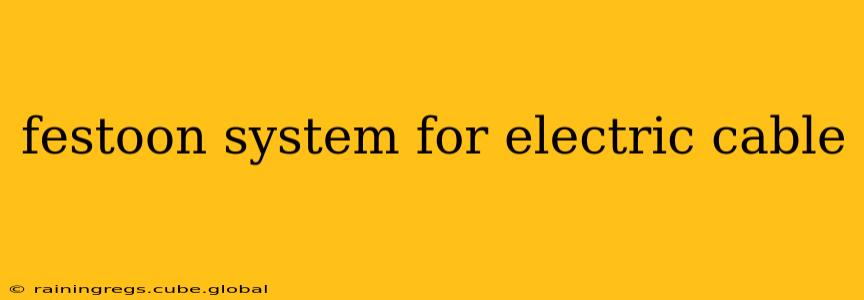Festoon systems provide a crucial solution for managing and protecting electric cables in dynamic environments where constant movement is required. From industrial settings to stage productions, these systems ensure safe and reliable power transmission, preventing cable damage and downtime. This guide delves into the intricacies of festoon systems, exploring their various components, applications, and benefits.
What is a Festoon System?
A festoon system is a specialized cable management system designed to support and protect electrical cables, pneumatic lines, and hydraulic hoses in applications requiring continuous movement. It typically consists of a series of trolleys, carriers, and a supporting track system. The cables are suspended and guided along the track, allowing for smooth and controlled movement without twisting, kinking, or excessive wear. This differs from other cable management methods like cable trays or conduits which are static. The dynamic nature of festoon systems makes them ideal for applications involving machinery with repetitive or continuous motion.
How Does a Festoon System Work?
The system operates on a simple yet effective principle. Cables are securely attached to carriers that glide along a track. The track is usually made of robust materials like steel or aluminum, chosen for durability and resistance to wear. The trolleys ensure smooth movement along the track, minimizing friction and preventing cable damage. The entire system is designed to handle the weight and movement of the cables, providing reliable power and data transmission even under demanding conditions. The carriers typically have clamps to securely hold the cables, preventing them from slipping or becoming detached.
What are the Different Types of Festoon Systems?
Several festoon system types cater to various needs and applications. These can be broadly categorized by:
- Material: Steel, aluminum, and even high-strength plastics are used in the construction of festoon systems. Steel systems offer superior strength and durability, while aluminum systems provide a lighter-weight option with good corrosion resistance. Plastic systems are often used in less demanding applications.
- Configuration: Systems can be configured for straight runs, curved paths, or complex three-dimensional layouts, depending on the application's specific requirements.
- Power Capacity: The system's capacity is determined by the track's strength and the carriers' design. Systems can support cables ranging from low-voltage control circuits to high-voltage power supplies.
- Environmental Considerations: Festoon systems are available with features to withstand harsh environments, such as weatherproofing, corrosion protection, and resistance to extreme temperatures.
What are the Components of a Festoon System?
A typical festoon system comprises the following key components:
- Track: The supporting structure along which the trolleys move.
- Trolleys: These carriers glide along the track, supporting the cables.
- Carriers: These secure the cables to the trolleys.
- End Stops: Prevent the trolleys from running off the end of the track.
- Cable Clamps: Secure the cables to the carriers.
What are the Benefits of Using a Festoon System?
The advantages of using a festoon system are numerous and contribute to increased efficiency and safety:
- Extended Cable Lifespan: The protected cable routing dramatically increases the lifespan of cables by preventing damage from abrasion, bending, and kinking.
- Improved Safety: The system reduces the risk of accidental cable damage and potential electrical hazards.
- Increased Efficiency: Reliable power and data transmission ensure uninterrupted operations and minimize downtime.
- Flexibility and Adaptability: Systems can be tailored to specific applications and easily adjusted as needed.
- Easy Maintenance: The modular design allows for easy access to components for maintenance and repair.
What are the Common Applications of Festoon Systems?
Festoon systems are widely employed across various industries and applications:
- Industrial Automation: Protecting cables on robotic arms, conveyor systems, and other automated machinery.
- Stage Lighting and Production: Managing power and data cables for moving lights, sound systems, and other stage equipment.
- Material Handling: Supporting cables on cranes, hoists, and other material handling equipment.
- Parking Garage Systems: Managing cables for parking barriers and other equipment.
- Outdoor Signage: Protecting cables for digital signage and other outdoor displays.
What Factors Should I Consider When Choosing a Festoon System?
Selecting the right festoon system necessitates careful consideration of several factors:
- Cable Type and Size: The system must be capable of supporting the specific cables being used.
- Movement Requirements: The system must accommodate the required range of motion and speed.
- Environmental Conditions: The system must withstand the environmental factors present in the application.
- Load Capacity: The system's load-bearing capacity must meet the weight of the cables and any additional loads.
- Budget: The cost of the system is an important consideration.
How Much Does a Festoon System Cost?
The cost of a festoon system varies significantly depending on factors like length, material, complexity, and additional features. It's best to obtain quotes from several suppliers to compare pricing.
How Long Do Festoon Systems Last?
With proper maintenance, festoon systems can last for many years, even decades, depending on usage and environmental conditions. Regular inspection and lubrication are crucial for extending their lifespan.
This comprehensive guide offers a thorough understanding of festoon systems for electric cables. Remember to consult with industry professionals to determine the optimal system for your specific requirements.
